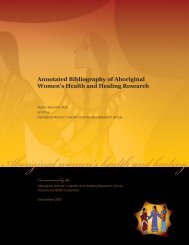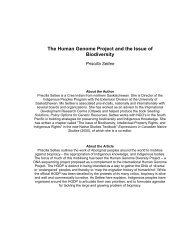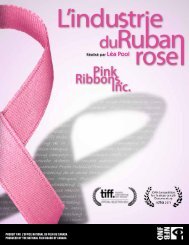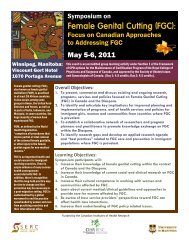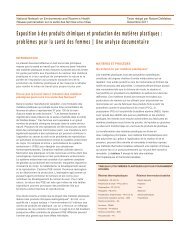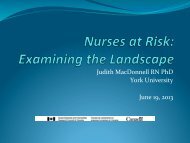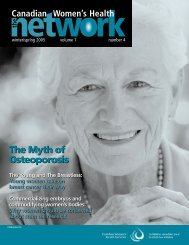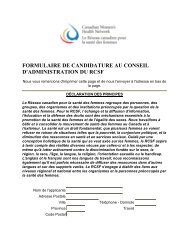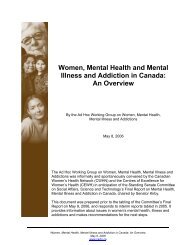Women, Income and<strong>Health</strong> in Manitoba26society over time, because ofdifferences in the structure ofwomen’s employment. For example,in Finland, 90% of women work fulltimethroughout their working life,and their own occupation has astrong influence on their health. 44In Canada, w<strong>here</strong> labour marketparticipation rates among women arelower, and w<strong>here</strong> systemic discriminationmeans that for married women, theirown occupation or earnings may not bereflective of the socioeconomic statusof the family, this is an importantconsideration and one which isdemonstrated in Denton and Walters’finding that occupation was not a strongpredictor of women’s health status.More recently, in her background paperfor the British Independent Inquiry intoInequalities in <strong>Health</strong>, Sara Arber hasargued for:the importance of using a clearconceptual model of the linkagebetween socio-economic measuressuch as educational qualifications,occupational class, employmentstatus and material resources(such as housing, car ownership andincome) in order to fully understandinequalities in health. It is necessaryto simultaneously analyse all thesefactors using multi-variate models,and for women with partners totake into account both their owncharacteristics and the socioeconomiccharacteristics oftheir partner. 45Researchers in Manitoba may have theopportunity to do this using the results ofthe 1996 National Population <strong>Health</strong>Survey (NPHS). In Manitoba, the provincialgovernment paid for the cost of increasingthe sample size, so that conclusions whichare stronger statistically may be drawnfrom the data. It may be possible to buildon the work of Denton and Walters,specifically for Manitoba, by combining theManitoba NPHS data with Manitoba<strong>Health</strong>’s existing health services utilizationdata. This would provide a uniqueopportunity to pursue these questions,and their answers, locally.Like Denton and Walters, Arber lookedat both an objective measure of health(limiting long-standing illness) and asubjective measure of health (selfassessedhealth). She found an interestingdifference between the two measures. Inher study, both car ownership and housingtenure were significantly associated withself-assessed health, but not with limitinglong-standing illness. For both women andmen, those living in public housing andthose with no car in the household reportedpoorer health. She noted that car ownershipwas a particularly salient issue for women’sself-assessed health. 46 She further notedthat “adverse material conditions havea particularly negative effect on selfassessedhealth if women are notin paid employment.” 47In a smaller, in-depth study of women inLiverpool, Ruth Young conducted a “timespaceanalysis” of women’s health-relatedbehaviours, 48 which included factors suchas car ownership and housing status, aswell as income, access to telephoneservice, task sharing within the household,location of employment and access topublic transport. She developed a framework,with four scales of “time-spaceconstraint” which work in concert toinfluence the ability of women to care fortheir own health. These four scales are:1. economic and social resources;2. domestic labour and caring constraint;3. paid employment constraint, and4. individual health status. 49The first three are the result of socioeconomicstatus and the fourth, the healthof the individual woman is correlated withsocioeconomic status. She noted thatwomen are the health managers in a
majority of British households,regardless of class or ethnic group.For women in lower socioeconomicgroups, this may have negativeconsequences.In circumstances of scarce availabletime and few resources, t<strong>here</strong>fore,women may ‘choose’ to neglect theirown health needs in order to achievethe best possible overall outcome forthe family. Consequently...behaviourswhich can look ‘irrational’ or‘unreasonable’ to health professionalsoften have readily understandableorigins in the complex and sociospatialstructures which constitutewomen’s everyday lives. 50The image of the self-sacrificing motherwho, when faced with inadequate resources,gives greater importance to the needs(and sometimes wants) of her family, ratherthan to her own needs, is one which is wellentrenched in <strong>Canadian</strong> society. This hasbeen compounded by cutbacks in healthservices, which increase the burden onfamily members, mostly women, to carefor their ill relatives. The extent to whichwomen’s altruism, which is socially valuedand publicly lauded, is actually detrimentalto women’s health, is not known.Denton and Walters, in their analysis of theNational Population <strong>Health</strong> Survey data,looked at behavioural as well as structuraldeterminants of health. The behaviouraldeterminants they included in their analysiswere smoking, alcohol consumption,physical activity and over/underweight.The structural determinants which theyincluded were age, family structure, socialeconomic condition, main activity andsocial support.It is noteworthy that they found that forself-perceived health, structural variablesexplained 19% of the variation for bothmen and women, while behaviouraldeterminants accounted for 15% of thevariation for men and 11% for women.For functional health status, structuraldeterminants accounted for 21% of thevariation for men and 24% for women,while behavioural determinants accountedfor 9% of the variation for both women andmen. 51 This means that for the womenin this study, lifestyle factors accountedfor less than 40% of the varianceexplained by structural factors.This is noteworthy and should beconsidered in planning projects aimedat improving women’s health status.It suggests that a focus on access tohealth services or on lifestyle factors(diet, exercise, smoking and alcoholconsumption), rather than on structuralfactors which influence health, will beless successful than those whichinclude an understanding of the impactsof the structural determinants on thehealth of women.Women, Income and<strong>Health</strong> in Manitoba274. The Connections with Employment StatusWe know from the work described above,that household income and women’sown education are strongly linked to theirhealth and that women’s own occupationis less strongly associated with inequalitiesin health.Bonnie Janzen, in her literature reviewpublished by the Prairie Women’s <strong>Health</strong>Centre of Excellence, described thecomplexities in understanding theconnection between women’s employmentstatus and inequalities in health:The relationship between healthand employment among women iscomplex. Available evidence suggeststhat paid work may certainly have apositive influence on women’s wellbeingas a result of increased income,
- Page 1 and 2: WOMEN, INCOME ANDHEALTH IN MANITOBA
- Page 3 and 4: TABLE OF CONTENTSPageA. EXECUTIVE S
- Page 5 and 6: EXECUTIVE SUMMARYTHE LINK between p
- Page 7 and 8: Women, Income andHealth in Manitoba
- Page 9 and 10: B. INTRODUCTIONMuch work has been d
- Page 11 and 12: Consistent with the majority of soc
- Page 13 and 14: Health and Well-Being of Children i
- Page 15 and 16: Women, Income andHealth in Manitoba
- Page 17 and 18: members of different visible minori
- Page 19 and 20: Women, Income andHealth in Manitoba
- Page 21 and 22: 3. How has the connection between i
- Page 23 and 24: E. INCOME AND THE HEALTH OF WOMEN -
- Page 25: Women, Income andHealth in Manitoba
- Page 29 and 30: Women, Income andHealth in Manitoba
- Page 31 and 32: The following chart, based on a cha
- Page 33 and 34: marsh potatoes, berries, etc. As a
- Page 35 and 36: opportunities for women may beone o
- Page 37 and 38: 2. Manitoba Data - Income and Healt
- Page 39 and 40: CHART 3HEALTH CARE EXPENDITURES ON
- Page 41 and 42: 3. What Does This Mean?As in other
- Page 43 and 44: procedures. It is noteworthy that t
- Page 45 and 46: 2. The Commonwealth Secretariat -Mo
- Page 47 and 48: Women, Income andHealth in Manitoba
- Page 49 and 50: H. MAKING PUBLIC POLICY HEALTHIER F
- Page 51 and 52: against women and its consequences
- Page 53 and 54: 3.3 CHILD TAX BENEFITThe Government
- Page 55 and 56: Household Basic Rent Rent Including
- Page 57 and 58: If RHAs are open to suchcollaborati
- Page 59 and 60: APPENDIX 1:SUGGESTIONS FOR FUTURE R
- Page 61 and 62: Women, Income andHealth in Manitoba
- Page 63 and 64: APPENDIX 3:HEALTH SERVICE UTILIZATI
- Page 65 and 66: APPENDIX 4:INTERVIEWS WITH ABORIGIN
- Page 67 and 68: Women, Income andHealth in Manitoba
- Page 69 and 70: Women, Income andHealth in Manitoba
- Page 71 and 72: Women, Income andHealth in Manitoba
- Page 73 and 74: ELEMENT #11GENDER SENSITIVE TRAININ
- Page 75 and 76: Women, Income andHealth in Manitoba
- Page 77 and 78:
ENDNOTES1. Sarlo, Christopher, “P
- Page 79 and 80:
ENDNOTES (continued)45. Arber, Sara
- Page 81 and 82:
ENDNOTES (continued)88. Mustard, Ca
- Page 83 and 84:
REFERENCES (continued)Clarke, H.F.
- Page 85 and 86:
REFERENCES (continued)Macintyre, Sa
- Page 87 and 88:
REFERENCES (continued)Vancouver/Ric




